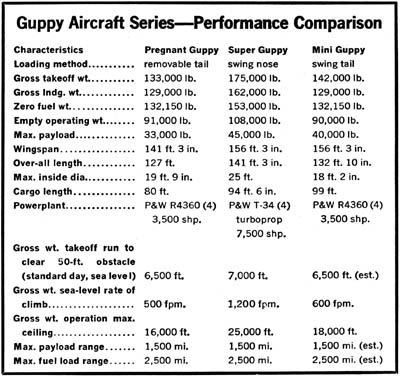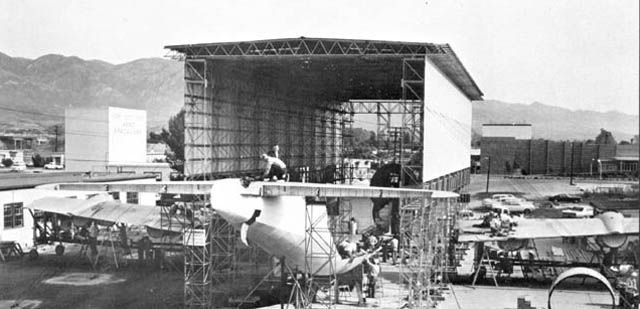open by manual operation of a worm-and-gear mechanism.
The center-of-gravity location of the wheel ensures that only minimal
empennage loads are transmitted to the two vertical fuselage attachment
hinges during this operation.
The Mini Guppy does not include any structural fail-safe provisions.
However, its designers point out that the Boeing Model 377 airframes
used in the Guppy aircraft series have an average of only about 30,000
hr. each, with no history of structural-fatigue failures, and that
Douglas Aircraft designs of comparable vintage have accumulated up
to 75,000 hr. of service.
The latest Guppy version, like the others, is the brainchild of
John M. Conroy, company president. The decision to proceed with
its construction was preceded by a market servey which, the company
claims, established a firm need for an outsized air-transport capability
in commercial applications. Open letters of support and interest
for these possibilities from NASA, Boeing, Fairchild Hiller, Northrop
and two separate divisions of Martin Co., have been enclosed by
Aero Spacelines with its application to the Civil Aeronautics Board
for supplemental carrier certification.
The Mini Guppy is the first of a planned commercial
fleet to be |

used for airlifting aircraft sections, helicopters,
oil drilling equipment and other cargo too large for existing
transport designs, and is a backup for the present NASA and
DOD operations.
Soon after its completion, the Mini Guppy flew from Santa
Barbara to Philadelphia. Then hauled a Budd Co. Skylounge
from Philadelphia to Paris. After exhibition at the recent
air show, the Mini Guppy was flown to Toulouse for a demonstration
for Sud Aviation and British Aircraft Corp. officials of its ability to
carry Concorde supersonic transport assemblies. |
The aircraft returned to Paris before
flying back to Santa Barbara. Aero Spacelines future plans
include:
*Replacement of the center wing section in the Pregnant
Guppy with a new beefed-up version, developed for the Mini
Guppy, during the next major overhaul.
*A turbine-powered version of the Mini Guppy equipped with four 4,680 hp. Allisons,
to increase payload to 60,000 Ib. and cruising speed to
300 mph. The wing center section in the present Mini Guppy
|
|

